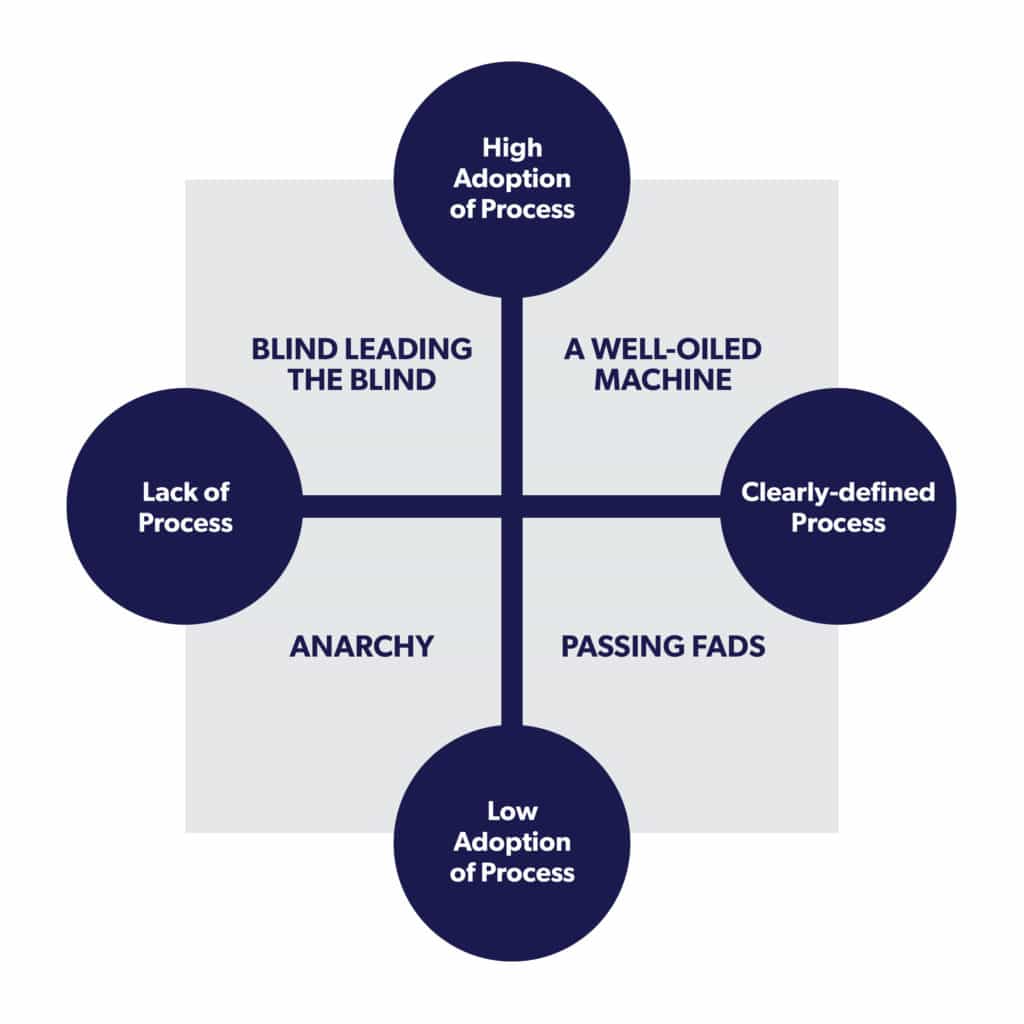Listen to the audio version of today’s tidbit!
It’s almost embarrassing to write this, but do you know what one of my absolute favorite things about business is?
The cliche answer would be that there’s “always a new challenge.” That it’s unpredictable. That it’s exciting. That it’s a thrill to see a new problem and be able to find a way to solve it for the first time.
And those answers would be dead wrong.
My favorite thing about business is how staggeringly predictable it can be. My favorite thing is knowing that when I walk into a company that’s having problems with sales or customer service, there is a certainty that they are missing one of five key elements that I can help them fix. Once those areas are fixed, sales and profits start to rise immediately.
The reason the whole thing is predictable is because of processes. There are the processes that I use in diagnosing and prescribing changes for my clients, and there are the processes (or lack thereof) that are already being used within the company.
If you’ve been following my work for any length of time, you’ve heard me talk plenty about the importance of clearly-defined processes for sales, marketing, customer service, and just about every other customer-facing aspect of your business.
In the past year alone, I’ve worked with clients who are doing just a little over $10M in revenue, and clients who are healthily over $3B in revenue, and I’ve seen many of the same issues with both groups.
Even with the best of intentions, we often have organizations with either clearly-defined processes that aren’t being followed or a total lack of process in the most critical areas of growth.
In the graphic below, I sum up the four states that companies can be in when it comes to process utilization. Knowing where you are on this is the first step to being able to create predictable success within your company (in almost any growth area.)

The most common problem we encounter is passing fads as depicted by the lower right corner. This is where we introduce new tools, systems, and processes (all of which are desperately needed) but we get minimal adoption or follow-through from those impacted by the new changes. You’ve heard me refer to this before as the “This too shall pass” phenomenon. This is almost always because they’ve “seen it before.” Consultants come and go. New tools come and go. And management often refuses to turn “an ask,” into a “requirement.”
I often tell my clients that when we start doing what we need to do, they’re going to face pushback. They’re going to have people who don’t think they need to change anything. And that’s going to require management to make some tough decisions. It’s not always easy, but it’s one of the main reasons we see companies get stuck.
In the lower left, there’s a lack of process, and even if there were, their people would be unlikely to implement. It’s a state of anarchy.
In the upper left, we have the blind leading the blind. These are companies where people are willing to follow processes, but there are no formal processes in place. This leads to a situation where everybody is trained differently, or everybody creates their own way of doing things, which they may or may not follow meticulously.
Of course, the problem with this approach is that there is no standardization or oversight. Of the three “bad” quadrants, this is the best one to be in, because it is the most likely that you’ll be able to actually get adoption of your formalized processes once you put them into place.
And finally, in the upper right, you have a company that has clearly-defined processes with high adoption. These companies run like a well-oiled machine. Helping clients who are already in the upper right quadrant is about finding areas where they haven’t yet created processes, or helping them to put experimentation into place in order to ensure they are always leaving room to improve their processes.
It’s very fun (and profitable) work, but the truth is that these companies have already done the hard work of creating a culture that understands and celebrates the importance of processes. Think about it this way.
For those in sales, it’s all about the process before, during, and after the sale. Do you have and follow a clearly-defined sales process?
For customer loyalty, it’s about when happens after the sale is made. It’s about the hand-off from sales to customer success. Do you have a clearly-defined onboarding process?
For customer service, it’s about knowing how to deal with the most common customer-related challenges, and knowing how to handle the less-common ones.
In retail, it’s about what happens when the customer enters your establishment, inquiries an about a product, or visits the store to return a product. It’s about the marketing your e-commerce customers get, and the regular/consistent updates that go out to your distributors or retailers.
In service and hospitality, it’s about the entire experience and how you choreograph the guest’s experience.
You get the idea…
The question to consider is this: What quadrant are you in? If you’re not in the upper right quadrant, what’s stopping you from getting there?
Your Challenge For This Week: Consider the area that you most want to improve in your company (sales revenue, customer service, customer loyalty, etc.), and ask how many processes you have in place to achieve those goals. For each process, ask how well it’s being adhered to within your company. If the answers are “none” or “not very well,” then you know where to start working!
